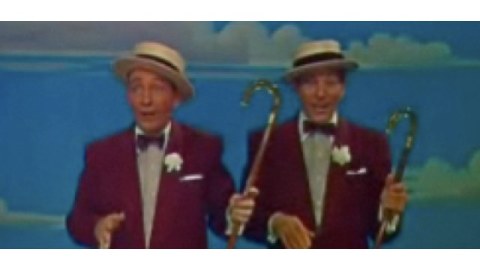What Eisenhower Republicans Had In Common With Occupy Wall Street

If you want to understand Occupy Wall Street and the frustration, rage and sadness that drive it, you could do worse than to watch White Christmas.
That’s the 1954 confection of schmaltz and Irving Berlin songs that celebrates Christmas, friendship, love and show business, in a typically overstuffed 1950’s-Hollywood way. It’s not just in color, it’s in colors so lush and bright that everyone in the cast looks fit to stand atop a wedding cake. And everything that had in earlier decades been modest and spare—the cars, the refrigerators, the Christmas presents—is enormous. The movie was even filmed with a process that used twice the surface area of normal 35-mm film, so make the images that much denser and richer.
When I was a teen-ager in the 1970s, we hated the vulgar ostentatiousness of this sort of thing, and the immense gap between its fantasies and real life. All the characters had so much stuff, and they all seemed too happy to be alive.
But watching the movie other night, I realized what I should have decades ago: Of course they were happy to be alive. They’d all survived a world war, and before that a Depression far worse than the one we’re limping through in 2011. If I had spent 20 years afraid of not getting enough to eat, of not surviving the year, of watching society collapse, I’d probably want to revel in life and a few consumer goods too. What had looked like an oppressive past when I was a teen-ager now looks like a distant dream for the future. Imagine it—general prosperity! no ongoing war!
Even more than safety and abundance, though, White Christmas celebrates safety and abundance for everyone. In the story, such as it is, Bing Crosby and Danny Kaye met as soldiers in World War II, and now they’ve made it big in show business. Their beloved former commander is going to go bankrupt unless business picks up at his Vermont inn. So Crosby calls all his fellow veterans to come and cheer the general up (and, obviously, provide a bit of what we’d now call economic stimulus and quantitative easing).
And they come—scores and scores of them, in their good suits, with their fat wallets, on shiny trains, carrying big suitcases—because they’ve all made it and they’re grateful to the old man for keeping them alive. You see them in a big ballroom at the end of the movie, shaking hands, hugging children, hoisting glasses. It’s not a 1930’s film, in which they would be plutocrats deciding whether to get divorced and pining for their last yacht. It’s a film from the 1950s, the houses and cars and refrigerators go to every regular Joe and Jane. Of course, the definition of “regular” didn’t include a lot of people (the only black people I noticed in the movie were making swell cocktails for the lucky Caucasians) but for those within the magic circle, the ideal is equality and shared riches. The lookalike veterans in the movie aren’t gated-community rich; they aren’t I’ve got mine, good luck to you rich. They’re rich together.
At mid-century in the United States, this wasn’t just a pious chestnut fit for a movie script. It was a principle, which motivated a different kind of behavior. Consider that quintessential , gray-haired, pants-up-to-his-chest 50’s executive, George Romney (father of Mitt). As David Leonhardt has recounted (kudos to Alex MacGillis for bringing it up this week) the senior Romney constantly turned down bonuses and pay raises. Once, he explained that no executive needed to make more than $225,000 a year (equivalent to about $1.4 million today) so he was refusing $100,000 bonus. Romney was a respectable Republican candidate for President in 1968, meaning that he was no enemy of free enterprise. It’s very unlikely that he believed that $100,000 for him meant $100,000 less for someone else. Rather, as MacGillis suggests, it just struck him as unseemly and unnecessary that one regular American should have that much more than another.
That frame of mind, I’m guessing, was born of shared hardship and war. It wasn’t much in evidence in 1928. And it’s not much in evidence in 2011. As much as it celebrates Christmas and love and prosperity and safety, White Christmas poignantly celebrates solidary. How great it must have been, after some hard, hard years, for millions of Americans to feel that they were all in this together.
Illustration: Bing Crosby and Danny Kaye engaged in job creation, from White Christmas via Wikimedia.




